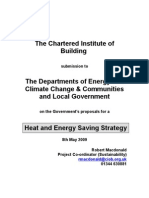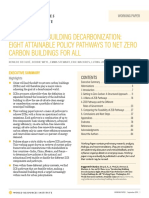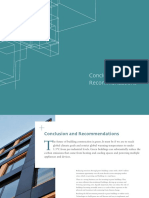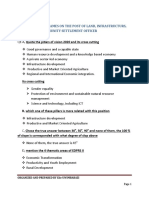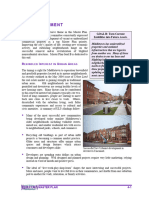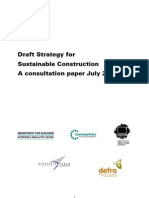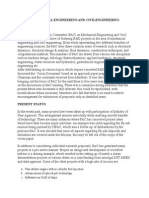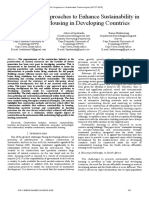0 ratings0% found this document useful (0 votes)
32 viewsLeading The Way: 4 Are There Enough Rungs On The Housing Ladder?
Leading The Way: 4 Are There Enough Rungs On The Housing Ladder?
Uploaded by
Reza EsfandiariThe document summarizes recommendations for restoring confidence in the housing market and developing sustainable communities. It stresses the importance of leadership at all levels. The recommendations include agreeing on a spatial framework for development, facilitating public-private partnerships for development, mobilizing public undesignated land for development through joint ventures, and attracting private funding for infrastructure to support community building and private investment.
Copyright:
© All Rights Reserved
Available Formats
Download as PDF, TXT or read online from Scribd
Leading The Way: 4 Are There Enough Rungs On The Housing Ladder?
Leading The Way: 4 Are There Enough Rungs On The Housing Ladder?
Uploaded by
Reza Esfandiari0 ratings0% found this document useful (0 votes)
32 views1 pageThe document summarizes recommendations for restoring confidence in the housing market and developing sustainable communities. It stresses the importance of leadership at all levels. The recommendations include agreeing on a spatial framework for development, facilitating public-private partnerships for development, mobilizing public undesignated land for development through joint ventures, and attracting private funding for infrastructure to support community building and private investment.
Original Description:
jdb
Original Title
4_532583727184792818_Part9
Copyright
© © All Rights Reserved
Available Formats
PDF, TXT or read online from Scribd
Share this document
Did you find this document useful?
Is this content inappropriate?
The document summarizes recommendations for restoring confidence in the housing market and developing sustainable communities. It stresses the importance of leadership at all levels. The recommendations include agreeing on a spatial framework for development, facilitating public-private partnerships for development, mobilizing public undesignated land for development through joint ventures, and attracting private funding for infrastructure to support community building and private investment.
Copyright:
© All Rights Reserved
Available Formats
Download as PDF, TXT or read online from Scribd
Download as pdf or txt
0 ratings0% found this document useful (0 votes)
32 views1 pageLeading The Way: 4 Are There Enough Rungs On The Housing Ladder?
Leading The Way: 4 Are There Enough Rungs On The Housing Ladder?
Uploaded by
Reza EsfandiariThe document summarizes recommendations for restoring confidence in the housing market and developing sustainable communities. It stresses the importance of leadership at all levels. The recommendations include agreeing on a spatial framework for development, facilitating public-private partnerships for development, mobilizing public undesignated land for development through joint ventures, and attracting private funding for infrastructure to support community building and private investment.
Copyright:
© All Rights Reserved
Available Formats
Download as PDF, TXT or read online from Scribd
Download as pdf or txt
You are on page 1of 1
• Both the location of new development and the application of building regulations should reduce
energy consumption and carbon emissions when evaluated in a holistic manner.
• Experience of innovation in the building process should be widely shared.
4 Are there enough rungs on the housing ladder?
• Local letting plans for social housing can reduce conflicts.
• Sites for new forms of tenure such as co-housing and self-build will foster innovation and community
building.
• Market rental has a greater role to play in speeding up occupation.
Leading the way
Chapter 3 summarises seven main messages, with recommendations for restoring confidence in the
housing market and getting development moving towards sustainable communities. It stresses the
importance of leadership at all levels. The recommendations follow.
1 Agree the spatial framework
Agreed regional and subregional spatial and transport investment plans are essential to give confidence to
developers to bring forward plans for sustainable communities that take years or even decades to come
to fruition. The report recommends that the Department for Communities and Local Government (DCLG)
and the Department for Business, Innovation and Skills (DBIS) should work with Local Enterprise
Partnerships to agree priority areas for growth and regeneration that can be reinforced in concordats (or
City Deals) extending over a number of years.
2 Facilitate public–private development partnerships
Partnerships bring together the best skills of the private sector in finance and development with the
commitment of the public and voluntary sectors to long-term community development and sustainability.
The Homes and Communities Agency should issue straightforward guidance on setting up public–private
development partnerships for agreed priority areas that will simplify the process and avoid unnecessary
legal costs.
3 Mobilise public undesignated land
Land cost is a key constraint and in appropriate places the easiest way to encourage house building is to
use publicly owned land to secure the best possible outcomes for both local people and the wider
community. Sustainable urban neighbourhoods can create value out of neglected land and will pay off
over a business or property cycle. Hence, development must be kick-started by putting more land into
joint ventures on a ‘build now, pay later’ basis. The report recommends that the Royal Institute of
Chartered Surveyors and The Housing Forum, with support from DCLG, should promote better and more
rigorous approaches to land valuation and disposal to get larger sites moving, following the government’s
Housing Strategy.2
4 Attract private funding for infrastructure
To support community building and private investment, advance infrastructure is needed in terms of
public transport provision, energy, waste, water and green space. The report recommends that the
Department for Business, Innovation and Skills (along with the Department of Energy and Climate
Executive summary 9
You might also like
- PlanningDocument222 pagesPlanningehsanrastayeshNo ratings yet
- Read The EmailsDocument153 pagesRead The Emailscrainsnewyork100% (1)
- Demolition Protocol 2008Document32 pagesDemolition Protocol 2008dragosgiligorNo ratings yet
- Green Building ProposalDocument22 pagesGreen Building Proposalsarvadh100% (1)
- English Teaching Professional Number 81 2012-07Document64 pagesEnglish Teaching Professional Number 81 2012-07Reza EsfandiariNo ratings yet
- Achieving Canadas Climate and Housing Goals Through Building Retrofits - Recommendations On Green Stimulus and Platform CommitmentsDocument14 pagesAchieving Canadas Climate and Housing Goals Through Building Retrofits - Recommendations On Green Stimulus and Platform CommitmentsNirali ShahNo ratings yet
- RTPI Briefing NotesDocument4 pagesRTPI Briefing Noteschoclate2012No ratings yet
- Good Practice Guidance - Sustainable Design and ConstructionDocument16 pagesGood Practice Guidance - Sustainable Design and Constructionk1l2d3No ratings yet
- Scorecard ExpfleissigjacobsenDocument27 pagesScorecard Expfleissigjacobsennohodi7191No ratings yet
- Scottish Government Good Practice Principles For Community Benefits From Onshore Renewable Energy DevelopmentsDocument42 pagesScottish Government Good Practice Principles For Community Benefits From Onshore Renewable Energy DevelopmentsbatambintanNo ratings yet
- SolutionsDocument6 pagesSolutionsfiorelamattominformalNo ratings yet
- Climate Emergency Urban Opportunity Priorities For National Governments FINALDocument3 pagesClimate Emergency Urban Opportunity Priorities For National Governments FINALLina Rocio RodriguezNo ratings yet
- CIOB Response Heat and Energy Saving Strategy ConsultationDocument6 pagesCIOB Response Heat and Energy Saving Strategy ConsultationMikeCNo ratings yet
- Roadmap 8 Page Low Res 1Document8 pagesRoadmap 8 Page Low Res 1mymalvernNo ratings yet
- 14 Chapter 11 ConclusionDocument5 pages14 Chapter 11 ConclusionSustainable Neighbourhoods NetworkNo ratings yet
- Recommendations of The Global Commission On People-Centred Clean Energy TransitionsDocument18 pagesRecommendations of The Global Commission On People-Centred Clean Energy TransitionsFrank VanoyNo ratings yet
- CW Affordable Housing TORs For CMSDocument9 pagesCW Affordable Housing TORs For CMSAKASH MISHRANo ratings yet
- EM2022LAS0205FMDocument11 pagesEM2022LAS0205FMRosalie BachillerNo ratings yet
- RFP Chennai Solar Rooftop Roadmap 1695394149Document12 pagesRFP Chennai Solar Rooftop Roadmap 1695394149kumki yaanaiNo ratings yet
- DownloadDocument4 pagesDownloadTchamko BorisNo ratings yet
- GBI Township Tool Booklet (Web) 201107 PDFDocument8 pagesGBI Township Tool Booklet (Web) 201107 PDFSrikanthTirlukaNo ratings yet
- Accelerating Building DecarbonizationDocument84 pagesAccelerating Building DecarbonizationAbeera Malik100% (1)
- Draft Energy Policy Framework CFTH SubmissionDocument6 pagesDraft Energy Policy Framework CFTH SubmissionsarahNo ratings yet
- Draft Energy Policy Framework CFTH SubmissionDocument6 pagesDraft Energy Policy Framework CFTH SubmissionsarahNo ratings yet
- BWEA - Offshore Wind Energy DevelopmentsDocument32 pagesBWEA - Offshore Wind Energy DevelopmentsnikifNo ratings yet
- 2013 Green Infrastructure Li Position StatementDocument32 pages2013 Green Infrastructure Li Position StatementKarliane MassariNo ratings yet
- Institutional and Financial Consideration For Rooftop Solar PVDocument22 pagesInstitutional and Financial Consideration For Rooftop Solar PVLone RangerNo ratings yet
- Conclusion and RecommendationsDocument18 pagesConclusion and RecommendationsAjinkya ShendarkarNo ratings yet
- Land Officer Document1-1Document30 pagesLand Officer Document1-1Theoneste NDIKURYAYO100% (2)
- Policy d4 Housing Quality and Standards CommentsDocument66 pagesPolicy d4 Housing Quality and Standards CommentsiliosXvanillaXXNo ratings yet
- Global Monitoring of Policies for Decarbonising BuildingsDocument20 pagesGlobal Monitoring of Policies for Decarbonising BuildingsHamza MoussaouiNo ratings yet
- Qcs 2014pdfDocument15 pagesQcs 2014pdfmekloyNo ratings yet
- Unlocking Public-Private Partnerships - A Toolkit For Local GovernmentsDocument113 pagesUnlocking Public-Private Partnerships - A Toolkit For Local Governmentschroma11No ratings yet
- Chapter 4 - Redevelopment PDFDocument13 pagesChapter 4 - Redevelopment PDFMahima SalujaNo ratings yet
- Cities Advice For Sustainable Housing - Sophie MoreauDocument75 pagesCities Advice For Sustainable Housing - Sophie MoreauEcosistema Urbano100% (2)
- Sustainable Construction Strategy DraftDocument77 pagesSustainable Construction Strategy DraftdoktormiesNo ratings yet
- Sustainable Residential Development in Urban Areas: (Cities, Towns & Villages)Document79 pagesSustainable Residential Development in Urban Areas: (Cities, Towns & Villages)Satish PandeyNo ratings yet
- Ready, Set, Grow:: How The Green Building Industry Can Re-Ignite Canada's EconomyDocument7 pagesReady, Set, Grow:: How The Green Building Industry Can Re-Ignite Canada's EconomyAlejandro BoccoNo ratings yet
- Market Renewal 2005-06 - FINALDocument54 pagesMarket Renewal 2005-06 - FINALEmpty HomesNo ratings yet
- FINALdraftgreensummitDocument3 pagesFINALdraftgreensummitmwardatwessaNo ratings yet
- National Housing PolicyDocument3 pagesNational Housing PolicyVisionnextPuneNo ratings yet
- Definition of Waste. Development Industry Code of PracticeDocument60 pagesDefinition of Waste. Development Industry Code of Practiceakhila sNo ratings yet
- A Policy On Architecture For Scotland: Review of PolicyDocument5 pagesA Policy On Architecture For Scotland: Review of PolicyThe Royal Society of EdinburghNo ratings yet
- Response To The Mayor's Good Practice Guide To Estate RegenerationDocument4 pagesResponse To The Mayor's Good Practice Guide To Estate RegenerationtomcopleyNo ratings yet
- Verdantix Low Carbon Real Estate Fund Launched in The UKDocument7 pagesVerdantix Low Carbon Real Estate Fund Launched in The UKAlfonso PonceNo ratings yet
- Civilengineeirng Research TopicsDocument4 pagesCivilengineeirng Research TopicsRG SegaranNo ratings yet
- Energy Day: From The Content Group To The Climate ChampionsDocument3 pagesEnergy Day: From The Content Group To The Climate ChampionsJon Bisu DebnathNo ratings yet
- Tackling Transport Emissions Community Panel Report April 2021 PDFDocument68 pagesTackling Transport Emissions Community Panel Report April 2021 PDFtom jonesNo ratings yet
- b94727de-enDocument91 pagesb94727de-enAlex JoraNo ratings yet
- Chapter 5 Public Facilities REV 10 19Document23 pagesChapter 5 Public Facilities REV 10 19daksh2006meenaNo ratings yet
- Clean Development MechanismsDocument21 pagesClean Development MechanismsJeffNo ratings yet
- Delhi 5Document3 pagesDelhi 5fe2so4No ratings yet
- Arches Chatham Neighbourhood Plan 2022 To 2040Document52 pagesArches Chatham Neighbourhood Plan 2022 To 2040theoddballNo ratings yet
- Ganiyu - BO - Fapohunda - JA - Haldenwang - R - Construction Approaches To Enhance Sustainability in Affordable Housing in Developing Countries PDFDocument7 pagesGaniyu - BO - Fapohunda - JA - Haldenwang - R - Construction Approaches To Enhance Sustainability in Affordable Housing in Developing Countries PDFmsNo ratings yet
- Scaling The Solid Wall Exec SummaryDocument8 pagesScaling The Solid Wall Exec SummaryConsumer FocusNo ratings yet
- Strengthening Public-Private Partnerships To Accelerate Global Electricity Technology Deployment - Survey of Best PracticesDocument10 pagesStrengthening Public-Private Partnerships To Accelerate Global Electricity Technology Deployment - Survey of Best PracticescalinovaNo ratings yet
- ELECTRIC UTILITY ALIGNMENT WITH THE SDGs THE PARIS CLIMDocument34 pagesELECTRIC UTILITY ALIGNMENT WITH THE SDGs THE PARIS CLIMRafael OsunaNo ratings yet
- Contracts For Difference Renewable Energy Consultation Response Part ADocument19 pagesContracts For Difference Renewable Energy Consultation Response Part ASHARJEEL MUNAWARNo ratings yet
- N E W S C E F C: Cefc@treasury - Gov.auDocument8 pagesN E W S C E F C: Cefc@treasury - Gov.auNew England WindNo ratings yet
- Mayors Climate Protection Act McpAgreementDocument1 pageMayors Climate Protection Act McpAgreementrhawk301No ratings yet
- NDCs in 2020: Advancing renewables in the power sector and beyondFrom EverandNDCs in 2020: Advancing renewables in the power sector and beyondNo ratings yet
- Transforming the energy systemFrom EverandTransforming the energy systemNo ratings yet
- Presenting Your Project: Follow-UpDocument2 pagesPresenting Your Project: Follow-UpReza EsfandiariNo ratings yet
- AEF3 - Part of WorksheetDocument1 pageAEF3 - Part of WorksheetReza EsfandiariNo ratings yet
- Box 10: Greening The Landscape Through Sustainable Urban Drainage Systems' (SUDS) at Upton, NorthantsDocument1 pageBox 10: Greening The Landscape Through Sustainable Urban Drainage Systems' (SUDS) at Upton, NorthantsReza EsfandiariNo ratings yet
- It's Important To Plan For Community Governance, Green/public Space and Built Environment (Like The Cambridge Quality Charter)Document1 pageIt's Important To Plan For Community Governance, Green/public Space and Built Environment (Like The Cambridge Quality Charter)Reza EsfandiariNo ratings yet
- 4 532583727184792818 Part37Document1 page4 532583727184792818 Part37Reza EsfandiariNo ratings yet
- Figure 8: New Communities Take Time To EvolveDocument1 pageFigure 8: New Communities Take Time To EvolveReza EsfandiariNo ratings yet
- Test 3: How Well Does The Development Framework Ensure The Designs Appeal To Different Potential Markets?Document1 pageTest 3: How Well Does The Development Framework Ensure The Designs Appeal To Different Potential Markets?Reza EsfandiariNo ratings yet
- 4 532583727184792818 Part36Document1 page4 532583727184792818 Part36Reza EsfandiariNo ratings yet
- 4 532583727184792818 Part25Document1 page4 532583727184792818 Part25Reza EsfandiariNo ratings yet
- Box 15: Funding Sustainable Infrastructure in Vathorst, Amersfoort, The NetherlandsDocument1 pageBox 15: Funding Sustainable Infrastructure in Vathorst, Amersfoort, The NetherlandsReza EsfandiariNo ratings yet
- Urbn Design Principles and DesignDocument1 pageUrbn Design Principles and DesignReza EsfandiariNo ratings yet
- InglesssDocument14 pagesInglesssMARLEN GISELA ESQUIVEL CALYNo ratings yet
- Volcanoes Lesson (Without Worksheets)Document7 pagesVolcanoes Lesson (Without Worksheets)api-287109691No ratings yet
- Convolution For Discrete and Continuous Time SignalsDocument41 pagesConvolution For Discrete and Continuous Time SignalsnajlaNo ratings yet
- Spare Parts List US CaleoDocument25 pagesSpare Parts List US CaleoSwami Meera60% (5)
- V LedDocument4 pagesV LedAmandeep Singh GujralNo ratings yet
- Huong Dan Lap Dat Va Su Dung Van Chong Va PDFDocument4 pagesHuong Dan Lap Dat Va Su Dung Van Chong Va PDFDONGTA123No ratings yet
- Vitamins BiochemistryDocument12 pagesVitamins BiochemistrysisonvherNo ratings yet
- Shapeit SB1 Wordlist With TranslationsDocument86 pagesShapeit SB1 Wordlist With TranslationsCarito MoyaNo ratings yet
- Egyptian Pottery in Middle Bronze Age AshkelonDocument9 pagesEgyptian Pottery in Middle Bronze Age Ashkelonsychev_dmitryNo ratings yet
- Grade 1 - English Dictation ListDocument3 pagesGrade 1 - English Dictation ListJanaka BogahawaththaNo ratings yet
- LGSWWTP - Geotechnical Design BriefDocument32 pagesLGSWWTP - Geotechnical Design BriefAdrian FrantescuNo ratings yet
- Bunker Silo ManagementDocument5 pagesBunker Silo Managementmisteryo10No ratings yet
- BraisingDocument2 pagesBraisingMari RiveraNo ratings yet
- (123doc) Luyen Tap Can Bang Phan Ung Oxi Hoa KhuDocument6 pages(123doc) Luyen Tap Can Bang Phan Ung Oxi Hoa KhuHắc Tử ThiênNo ratings yet
- 1800 Calorie Meal PlanDocument5 pages1800 Calorie Meal PlanMariana Angeles100% (1)
- Lesson Twenty-Five: Summary SheetDocument11 pagesLesson Twenty-Five: Summary SheetMontu100% (1)
- High Voltage Dead Tank Circuit Breakers: Portfolio at A GlanceDocument2 pagesHigh Voltage Dead Tank Circuit Breakers: Portfolio at A Glancesani priadiNo ratings yet
- Block Diagram of Intel Atom ProcessorDocument23 pagesBlock Diagram of Intel Atom Processorfestio94No ratings yet
- Molex PowerCat 6A Shielded Patch CordsDocument1 pageMolex PowerCat 6A Shielded Patch CordsRedingtonValueNo ratings yet
- Instruction of Led Pool Light/Lplr210/180Document4 pagesInstruction of Led Pool Light/Lplr210/180alberto lazoNo ratings yet
- Abrasive Water Jet MachiningDocument11 pagesAbrasive Water Jet MachiningAngel AngelNo ratings yet
- Investigation Into Study Of: Smart Sensing Methods For The Health Monitoring ofDocument11 pagesInvestigation Into Study Of: Smart Sensing Methods For The Health Monitoring ofMuhammad Adeel0% (1)
- Modern Numerical Relay For Power System Protection PDFDocument4 pagesModern Numerical Relay For Power System Protection PDFanon_226017855No ratings yet
- Method Statement Format For MepDocument6 pagesMethod Statement Format For Mepven195967% (3)
- Gounand - Sujet Post Doc PTC Simulation FADocument1 pageGounand - Sujet Post Doc PTC Simulation FAnguyenvanlinhNo ratings yet
- Workstation Ergonomics Self-AssessmentDocument5 pagesWorkstation Ergonomics Self-AssessmentmuslimnswNo ratings yet
- Latitude and Longitude (1) .pdf-96Document3 pagesLatitude and Longitude (1) .pdf-96RupasinghNo ratings yet
- Crucetas PDFDocument8 pagesCrucetas PDFArielNo ratings yet
- Ipc2012 90730Document8 pagesIpc2012 90730Marcelo Varejão CasarinNo ratings yet












